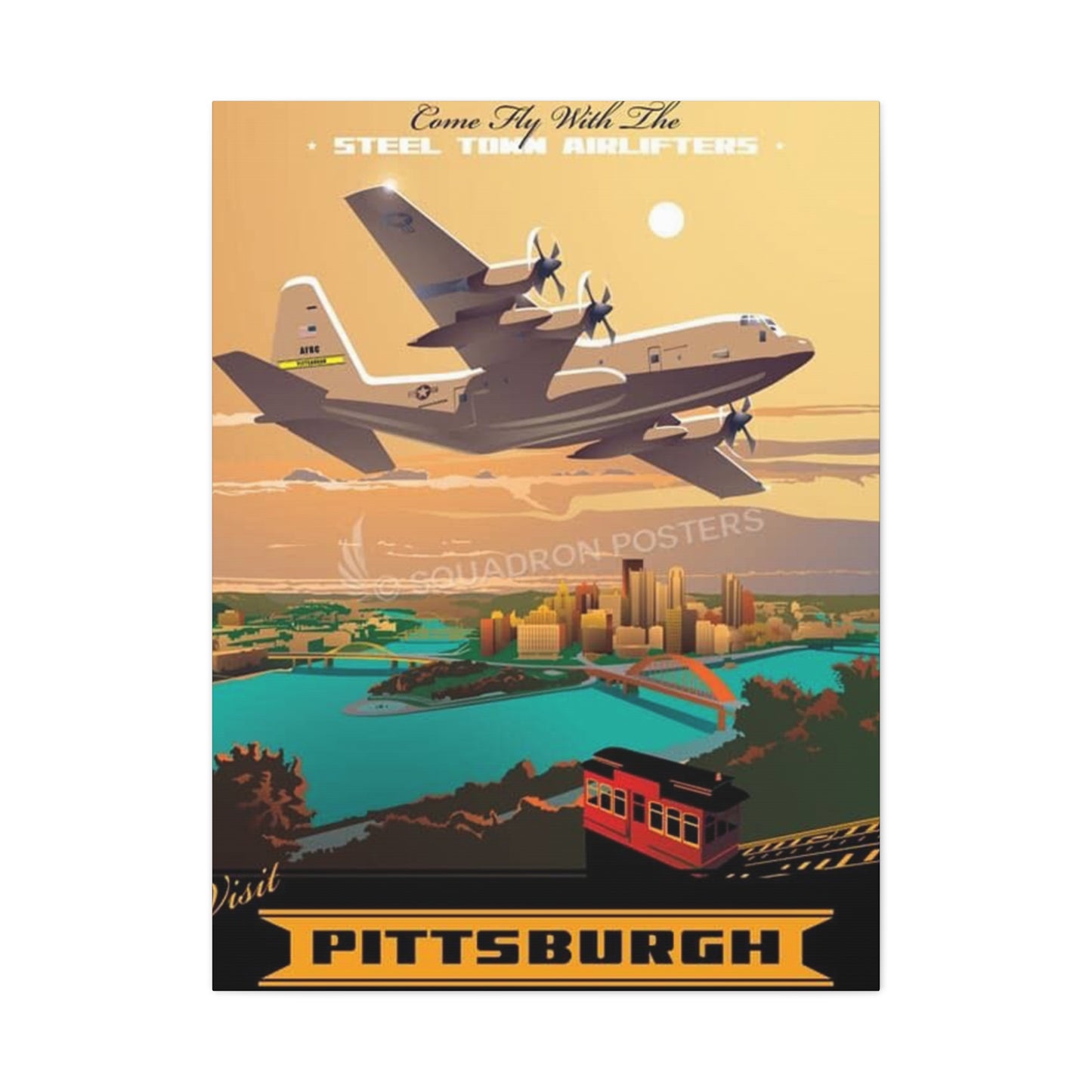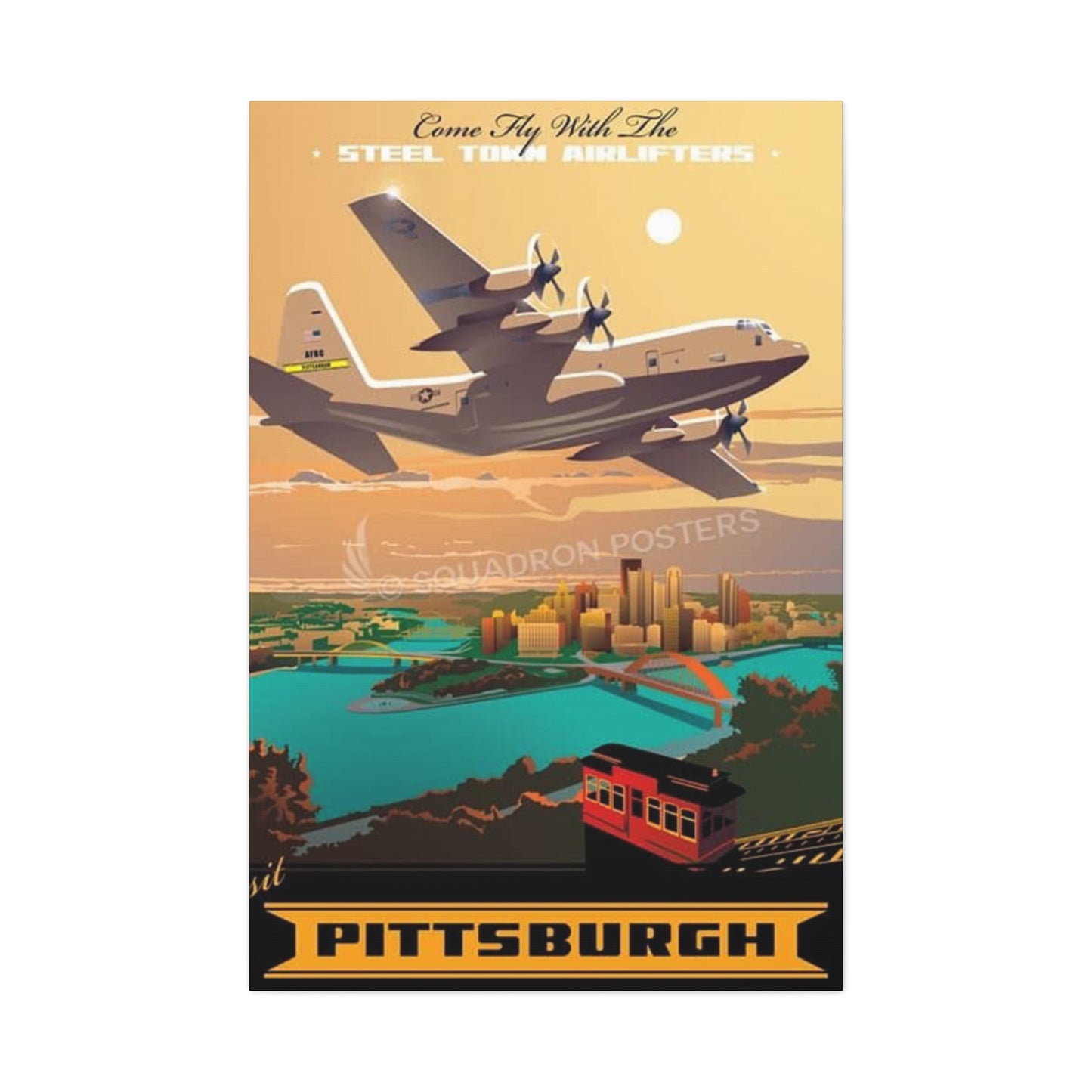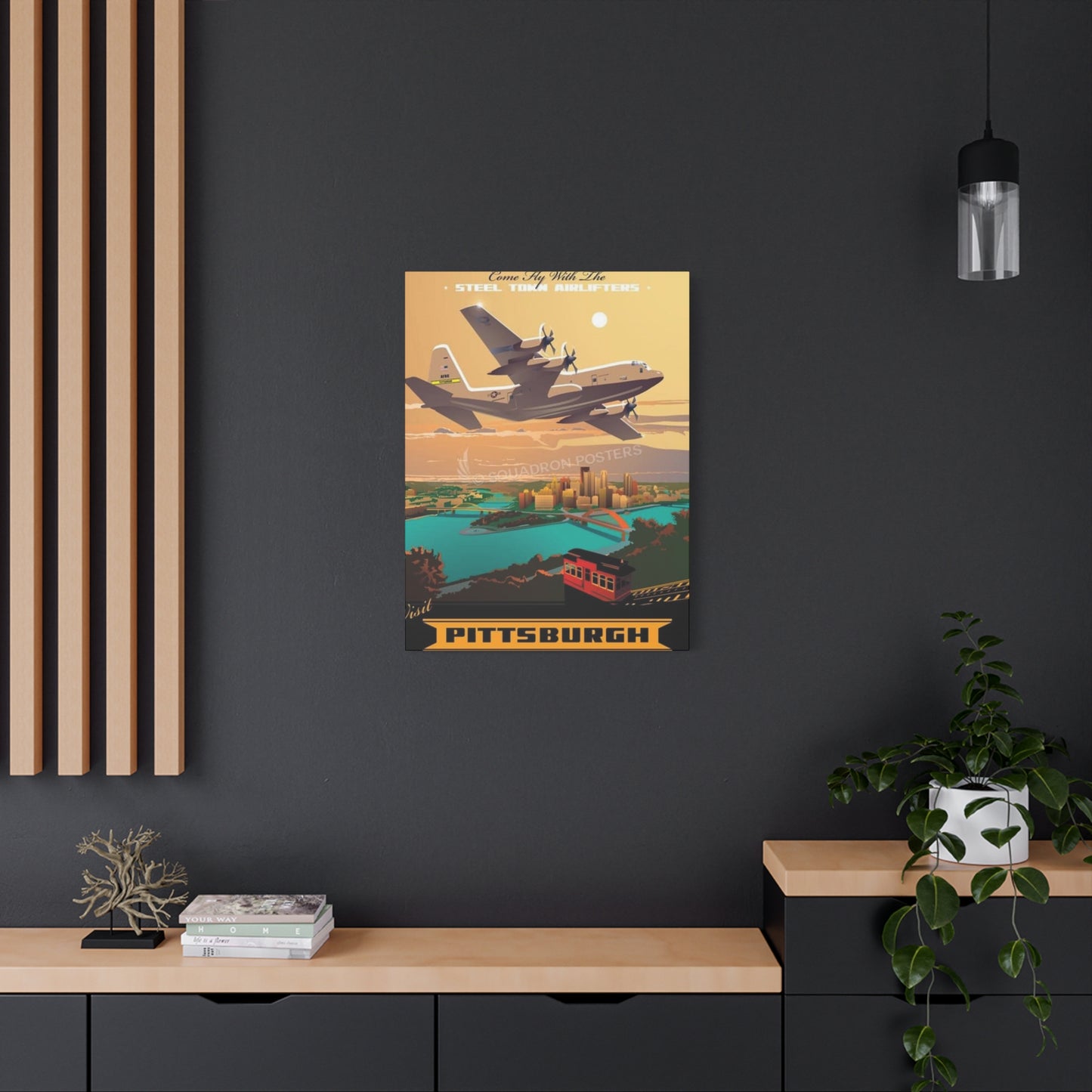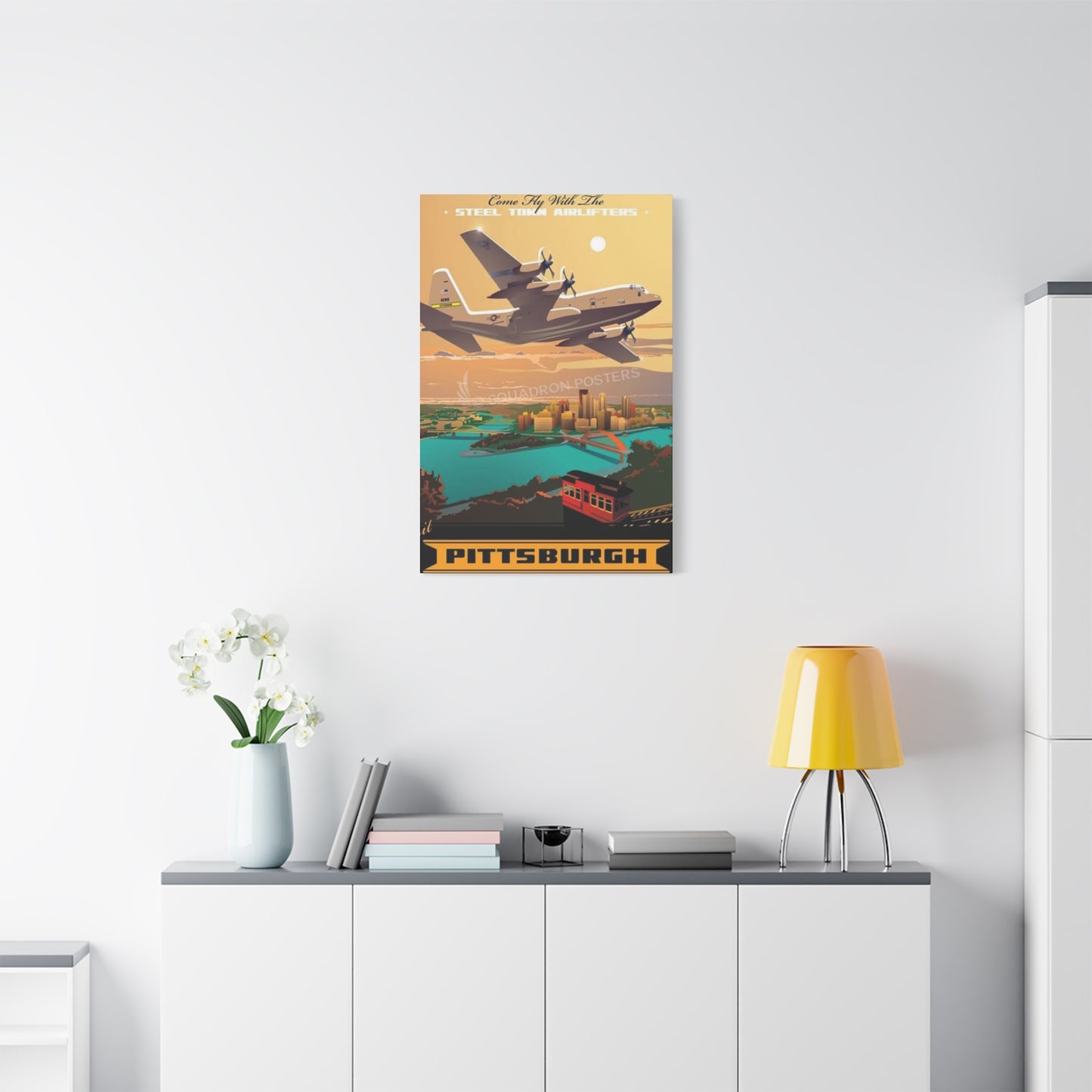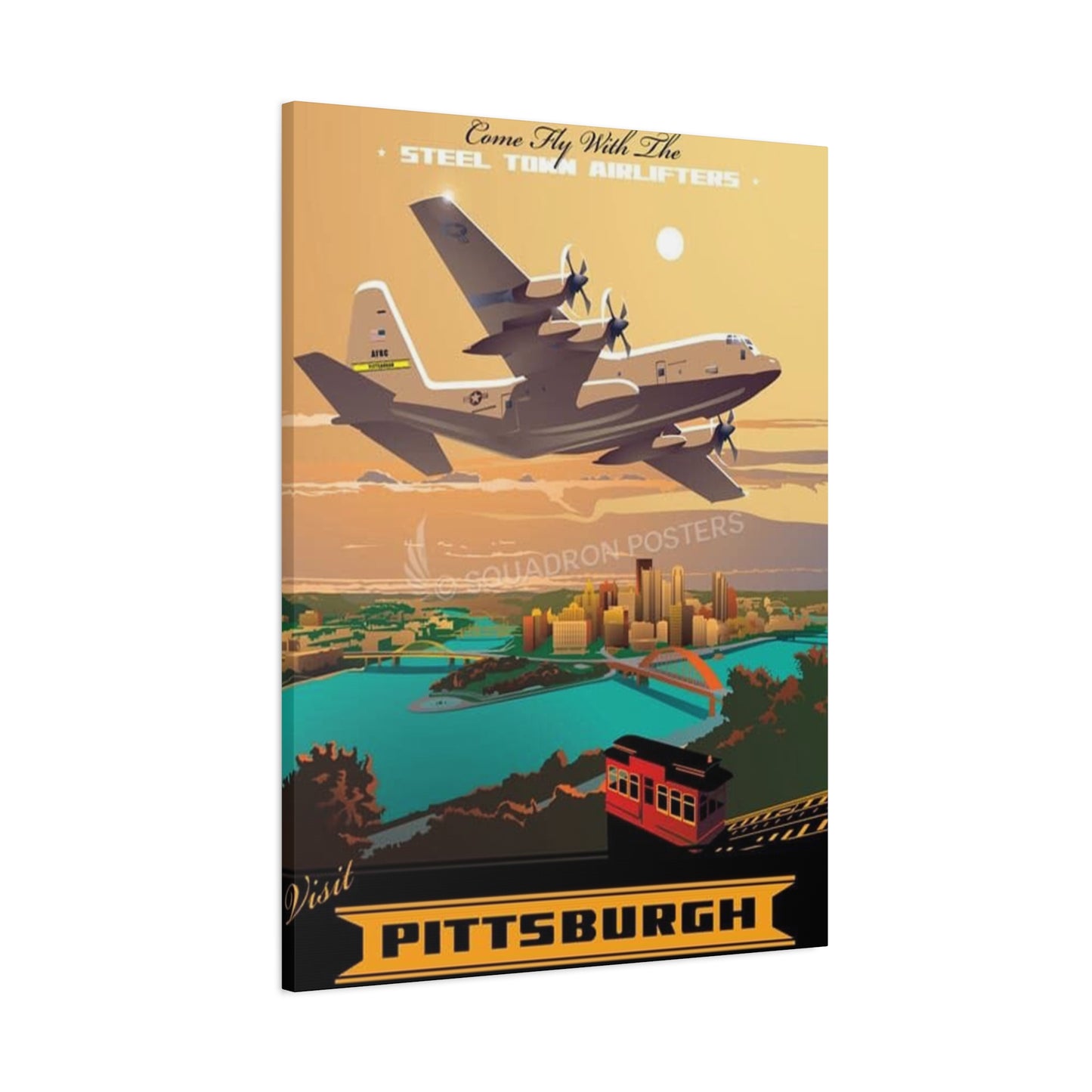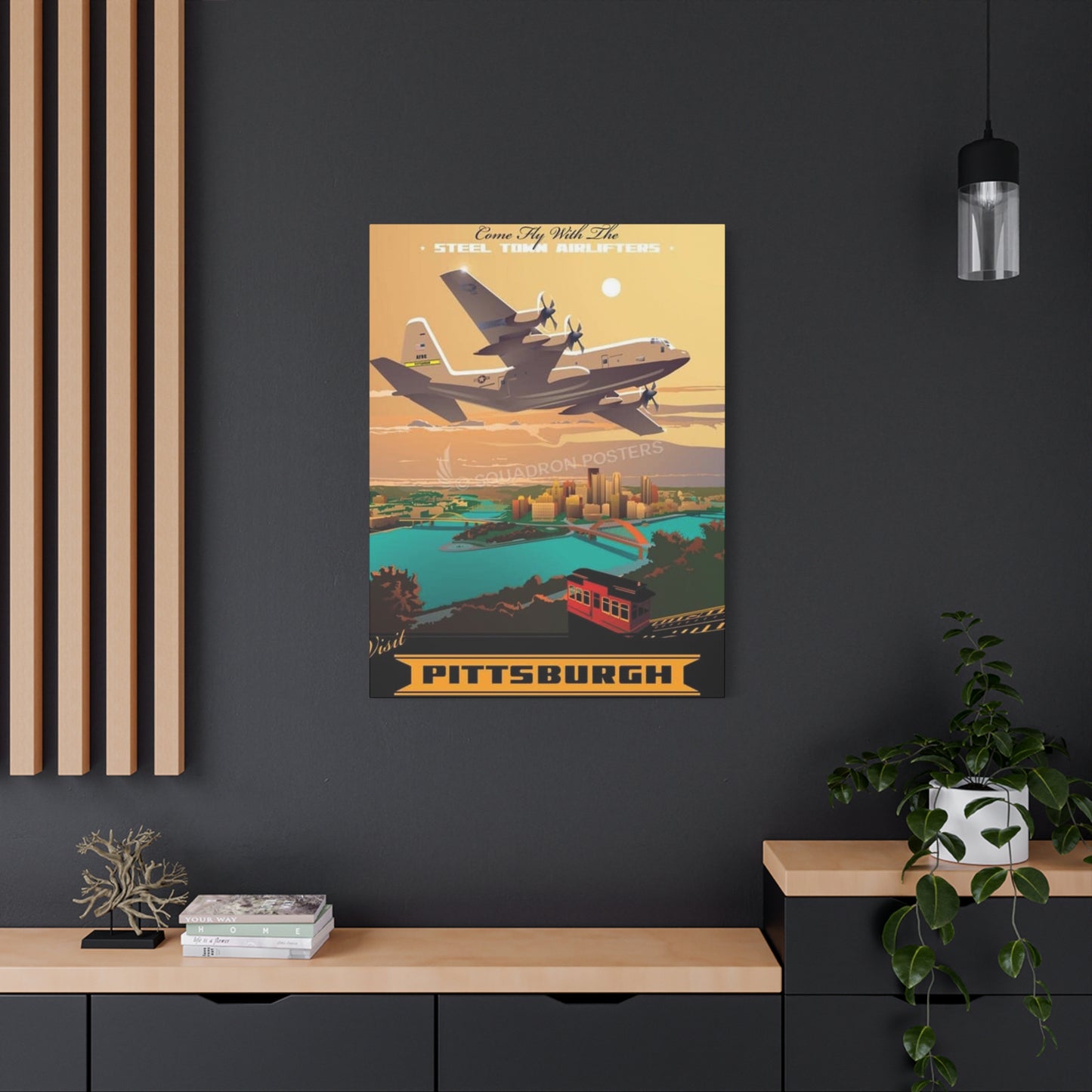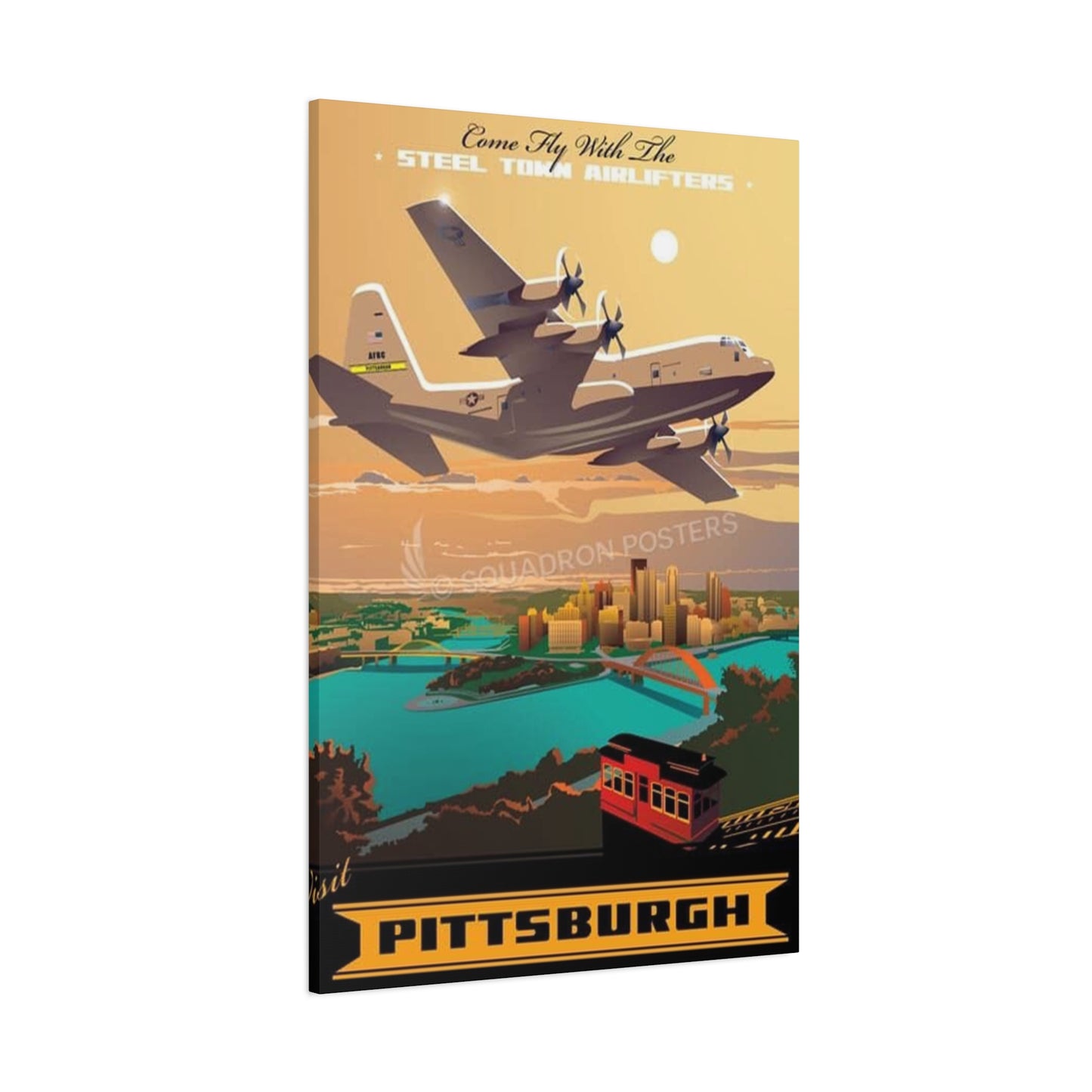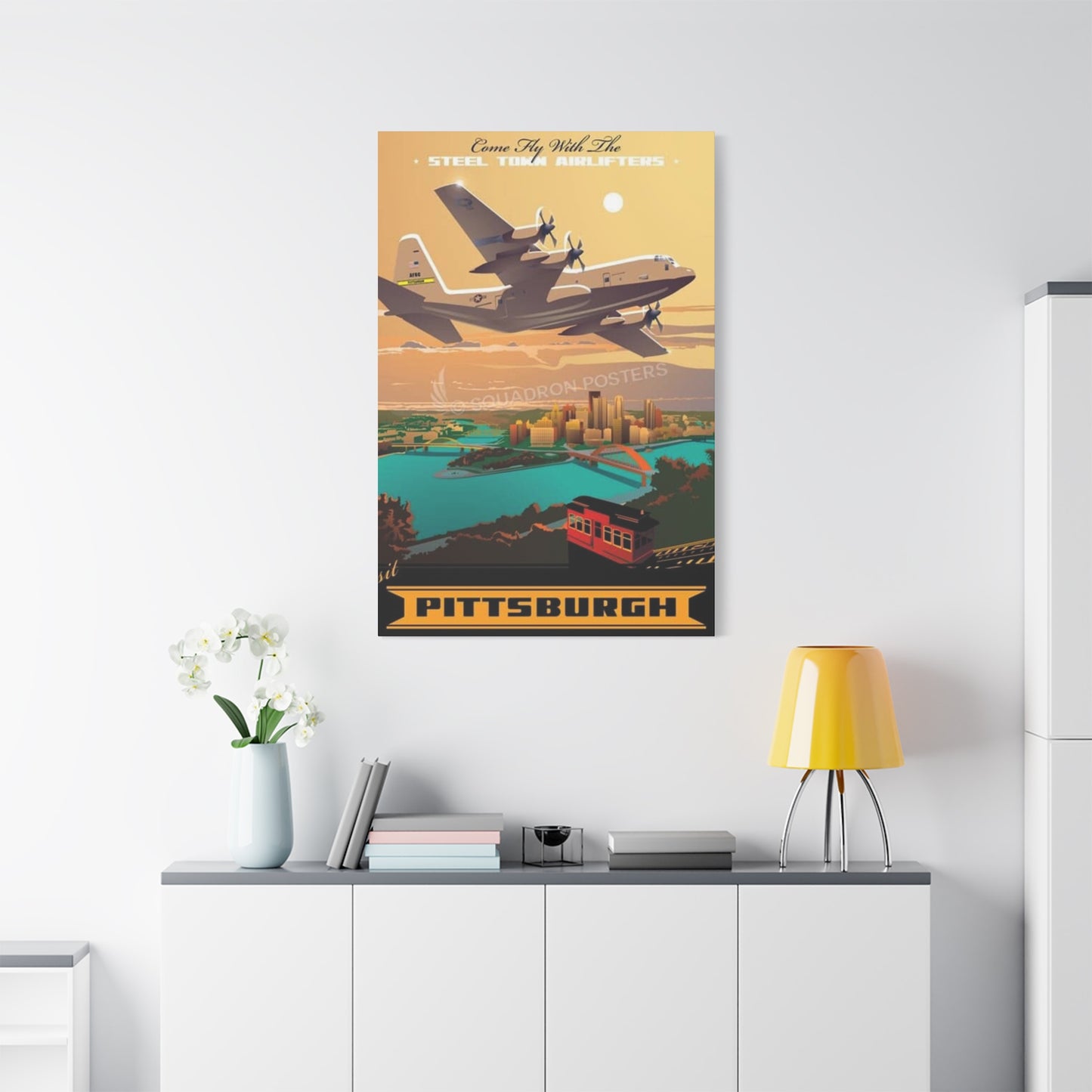The Strength of Steel and Sky: Pittsburgh Airlifter Poster Wall Art for Urban Décor
The concept of a Pittsburgh Airlifter in Flight represents far more than a simple visual representation of an aircraft soaring above a city. This imagery encapsulates decades of aviation history, industrial heritage, and the indomitable spirit of a metropolis that has consistently reinvented itself while maintaining deep connections to its manufacturing and transportation roots. When we examine the Pittsburgh Airlifter in Flight as both a historical reference and contemporary artistic expression, we discover layers of meaning that speak to technological achievement, community identity, and the enduring human fascination with conquering the skies.
Pittsburgh's relationship with aviation extends back to the earliest days of powered flight, when the city's industrial capacity and strategic location made it a natural hub for aircraft manufacturing and military aviation operations. The airlifter aircraft, designed primarily for cargo and personnel transport, became particularly significant during the mid-twentieth century when global conflicts and humanitarian missions demanded reliable, heavy-duty transport capabilities. These massive aircraft represented engineering excellence and operational necessity, capable of carrying enormous payloads across vast distances while operating from varied and sometimes challenging airfields.
The visual impact of an airlifter in flight above Pittsburgh creates a striking juxtaposition between human innovation in two distinct realms. Below lies the urban landscape, with its bridges spanning the confluence of three rivers, its hills dotted with neighborhoods that reflect generations of immigrant communities, and its skyline marking the transition from steel mills to technology centers. Above, the airlifter cuts through the atmosphere, its substantial form defying gravity through principles of aerodynamics that represent centuries of scientific inquiry and practical engineering application.
For aviation enthusiasts and historians, the Pittsburgh Airlifter in Flight imagery serves as a reminder of specific aircraft types that have graced the skies above this region. The C-130 Hercules, various models of the Galaxy transport series, and other military and civilian heavy-lift aircraft have all played roles in Pittsburgh's aviation story. These aircraft have transported everything from critical manufacturing components to humanitarian relief supplies, from military personnel to civilian evacuees during emergencies. Their presence above the city represents capability, readiness, and the global connections that even regional centers maintain in an interconnected world.
The artistic interpretation of a Pittsburgh Airlifter in Flight allows creators to explore themes of power, movement, and scale. The sheer size of these transport aircraft provides dramatic visual possibilities when rendered against urban architecture or natural landscapes. Artists working in various media have captured the distinctive profiles of these aircraft, emphasizing the muscular functionality of their design, the purposeful arrangement of engines and control surfaces, and the sense of controlled power evident in their flight characteristics. Whether depicted in realistic detail or stylized abstraction, the airlifter maintains its essential character as a working aircraft built for serious missions rather than aesthetic appeal alone.
Collectors and decorators who seek Pittsburgh Airlifter in Flight artwork often appreciate how these pieces bridge multiple interests simultaneously. The imagery appeals to those with military backgrounds or family connections to armed services, to aviation professionals and enthusiasts, to Pittsburgh residents proud of their city's heritage, and to anyone who appreciates the intersection of industrial design and functional beauty. This broad appeal makes such artwork particularly versatile for residential spaces, offices, educational institutions, and public buildings where diverse audiences will encounter and interpret the imagery according to their own experiences and perspectives.
Iconic Airlifter Over Pittsburgh
The concept of an Iconic Airlifter Over Pittsburgh elevates the basic imagery of aircraft and cityscape to the realm of recognized symbols that carry cultural weight and emotional resonance. Iconography in visual culture refers to images that transcend their literal subjects to represent broader concepts, values, or identities. When an airlifter over Pittsburgh achieves iconic status, it becomes more than documentation of a specific aircraft at a particular location; it transforms into a symbol representing multiple layers of meaning that resonate with diverse audiences across different contexts and time periods.
The process by which particular images achieve iconic status involves complex interactions between visual composition, historical context, emotional resonance, and cultural circulation. An image must first possess inherent visual strength, with composition, lighting, perspective, and subject matter combining to create immediate impact that captures attention and sustains interest. Beyond this foundational visual quality, the image must connect with existing cultural narratives, collective memories, or shared values that give it significance beyond its literal content. Finally, the image must circulate sufficiently within relevant communities to achieve recognition and familiarity, becoming part of a shared visual vocabulary that people reference and reproduce.
For an airlifter over Pittsburgh to qualify as iconic, it must successfully represent both the specific aircraft type and the particular city in ways that resonate with audiences. The aircraft component brings associations with military service, logistical capability, humanitarian missions, and technological achievement. The Pittsburgh component introduces themes of industrial heritage, working-class identity, urban transformation, regional pride, and geographic distinctiveness. When these elements combine effectively in a single image, the result can transcend the sum of its parts, creating a representation that speaks simultaneously to multiple audiences about various aspects of their identities and values.
The visual characteristics that contribute to iconic status for airlifter imagery include several key elements. Scale relationships between aircraft and urban environment communicate both the impressiveness of the aircraft and the character of the city. A composition showing an airlifter flying at relatively low altitude over recognizable Pittsburgh landmarks emphasizes the size and power of the aircraft while also celebrating the city's architectural and geographic features. Lighting conditions that create dramatic contrasts or atmospheric effects enhance emotional impact without sacrificing clarity or legibility. Perspective choices that position viewers in relationship to both aircraft and landscape affect how audiences relate to and interpret the imagery.
Historical photographs of airlifters over Pittsburgh, particularly those documenting significant events or operations, can achieve iconic status through their documentary value combined with visual impact. Images capturing aircraft participating in airshows, military exercises, humanitarian missions, or ceremonial flights become historical records that gain significance over time. As the events themselves recede into history, the photographic documentation becomes increasingly valuable as evidence of what occurred and how it appeared to contemporary observers. Subsequent generations encountering these historical images connect with them not only as aesthetic objects but as windows into past experiences and perspectives.
The artistic interpretation of iconic airlifter imagery involves decisions about how much to emphasize realistic representation versus stylistic expression. Hyperrealistic approaches that capture every rivet and panel line in precise detail appeal to viewers who value technical accuracy and documentary fidelity. Stylized approaches that simplify forms, enhance colors, or abstract elements from their literal appearance can create more emotionally immediate responses and work more effectively as decorative art in contemporary spaces. The most successful iconic images often balance these considerations, maintaining sufficient accuracy to be recognizable and credible while incorporating artistic choices that enhance visual impact and emotional resonance.
Steel City Aviation Pride
Steel City Aviation Pride represents the intersection of Pittsburgh's industrial heritage with its ongoing relationship to aerospace and aviation. The nickname "Steel City" itself derives from Pittsburgh's dominance in steel production during the late nineteenth and much of the twentieth century, when the region's mills produced steel for applications ranging from bridges and buildings to ships and armaments. While steel production has declined dramatically from its peak, the nickname persists as an identifier carrying connotations of industrial strength, working-class identity, and manufacturing excellence that remain sources of regional pride despite economic transformations.
The connection between steel production and aviation runs deeper than simple chronological coincidence. Steel and its various alloys have served as crucial materials in aircraft construction throughout aviation history. Early aircraft used steel tubes in fuselage frames and other structural components where strength and predictability were essential. Engine components relied heavily on specialty steel alloys capable of withstanding extreme temperatures and stresses. Landing gear assemblies required steel for shock absorption and strength under impact loads. As aviation technology advanced, steel continued to play important roles even as aluminum and composite materials increasingly dominated airframe construction.
Pittsburgh's contributions to aviation and aerospace extend beyond material supply to encompass research, development, manufacturing, and operations across multiple eras and applications. Regional companies have produced aircraft components, avionics systems, and specialty materials used in military and civilian aircraft. Research institutions including universities and corporate laboratories have advanced knowledge in aerodynamics, propulsion, materials science, and systems integration. Military installations in or near the region have trained personnel, tested equipment, and conducted operations. This multifaceted engagement with aviation creates legitimate foundations for Steel City Aviation Pride beyond simple geographic association.
The pride component of Steel City Aviation Pride reflects psychological and social needs for positive collective identity and recognition of achievements. Communities derive satisfaction and self-esteem from recognizing and celebrating their contributions to broader endeavors and accomplishments. For Pittsburgh specifically, aviation pride serves as a contemporary expression of manufacturing excellence and technical capability that historical steel production represented. As economic foundations shift from heavy industry to education, healthcare, and technology, aviation and aerospace connections provide continuity with valued aspects of traditional identity while pointing toward future possibilities.
The visual culture of Steel City Aviation Pride encompasses various media and expressions beyond single images. Air shows held in or near Pittsburgh draw substantial crowds eager to observe military and civilian aircraft demonstrations. These events create community experiences where aviation enthusiasm combines with regional pride in hosting significant events. Museums and historical societies maintain collections of aviation artifacts, photographs, and documentation that preserve and interpret regional aviation history. Public art installations, memorials, and naming practices for buildings and infrastructure acknowledge aviation themes and honor individuals associated with regional aviation history.
The educational dimensions of Steel City Aviation Pride manifest in academic programs, youth organizations, and community initiatives focused on aviation and aerospace. Universities offer engineering programs with specializations relevant to aerospace applications. Vocational and technical schools provide training for aircraft maintenance and related skilled trades. Youth organizations including Civil Air Patrol squadrons and school aviation clubs introduce young people to aviation topics and career possibilities. These educational initiatives serve dual functions of preparing individuals for aviation careers while strengthening community connections to aviation themes and activities.
The economic aspects of Steel City Aviation Pride acknowledge the practical significance of aviation-related employment and economic activity. While Pittsburgh is not a major center of aircraft manufacturing comparable to Seattle, Southern California, or certain other regions, aviation-related employment remains economically significant through airlines, cargo carriers, general aviation services, component manufacturing, maintenance operations, and military installations. The Air Force Reserve maintains a significant presence in the region, providing employment and economic activity while contributing to community character. These economic realities give substance to aviation pride beyond mere symbolic gestures or nostalgic references.
The demographic characteristics of Pittsburgh's population influence how Steel City Aviation Pride manifests and circulates. High rates of military service among regional residents create substantial populations of veterans with direct aviation connections through their own service or that of family members. Working-class identification remains strong despite economic changes, creating cultural continuity with industrial-era identities that valued practical skills and tangible production. Aging population dynamics mean many residents remember eras when steel production was more prominent and when certain aircraft types were more common, creating generational differences in what specific aviation references evoke.
The competitive dimensions of regional pride create contexts where Steel City Aviation Pride distinguishes Pittsburgh from other cities and regions. Regional rivalries, whether in sports, economic development, or cultural achievements, motivate communities to identify and celebrate distinctive characteristics. Aviation connections provide one dimension where Pittsburgh can claim significance and achievements, particularly when linked with the city's broader manufacturing heritage and technical capabilities. This competitive aspect of pride should not be overstated but represents a real element of how communities construct and maintain collective identities.
The media representations of Pittsburgh and its aviation connections shape public perceptions and reinforce or challenge Steel City Aviation Pride narratives. Local news coverage of aviation events, airport developments, military operations, and aviation-related businesses contributes to maintaining public awareness and interest. Feature stories highlighting regional contributions to aviation history or current aerospace projects create opportunities for community members to learn about and take pride in these connections. Documentaries, books, and online content exploring Pittsburgh history increasingly incorporate aviation themes alongside traditional emphases on steel production and industrial development.
The architectural and memorial expressions of Steel City Aviation Pride take physical forms throughout the region. Airport terminals incorporate design elements and artwork celebrating aviation themes and local identity. Public monuments honor military veterans including those with aviation service. Museums maintain aviation exhibits among broader collections addressing regional history. These physical manifestations of aviation pride create tangible references that community members and visitors encounter, reinforcing the relationship between place and aviation through built environment and public spaces.
Bold Airlifter Poster Art
Bold Airlifter Poster Art represents a specific aesthetic approach to depicting transport aircraft that emphasizes visual impact, strong composition, and graphic clarity over photographic realism or subtle atmospheric effects. The poster art tradition, with roots extending back to late nineteenth-century commercial and political applications, has developed distinctive characteristics including simplified forms, bold colors, strong contrast, and clear focal points designed to capture attention and communicate efficiently. When these poster art principles apply to airlifter subjects, the result combines aviation content with graphic design sensibilities that create particularly effective decorative art for contemporary spaces.
The historical context of poster art provides important background for understanding bold airlifter poster approaches. Early posters served commercial and political purposes, advertising products, entertainment, and ideological positions to urban audiences encountering them in public spaces. The constraints of printing technologies and the need to communicate effectively at distance led to aesthetic choices emphasizing simplicity, contrast, and bold design elements. Artistic movements including Art Nouveau, Art Deco, and various modernist approaches contributed distinctive styles while maintaining poster art's fundamental communication functions. This rich tradition informs contemporary poster art including aviation-themed work.
The specific characteristics that define bold airlifter poster art include several key elements that distinguish this approach from other artistic interpretations. Color palettes tend toward saturated, high-contrast selections rather than naturalistic atmospheric tones, creating immediate visual impact and emotional response. Compositional choices position the airlifter prominently, often using low or elevated perspectives that emphasize the aircraft's size and power. Background elements become simplified or stylized, providing context and visual interest without competing with the aircraft for attention. Typography, when present, uses bold fonts and clear hierarchy to integrate text elements with visual imagery cohesively.
The production methods for bold airlifter poster art have evolved significantly with digital technologies while maintaining connections to traditional approaches. Historical poster production relied on lithography and other printing methods that imposed technical constraints influencing aesthetic choices. Contemporary digital tools enable precise color control, complex layering effects, and iterative refinement impossible or impractical with traditional methods. However, many contemporary poster artists deliberately adopt limitations and aesthetic characteristics derived from historical methods, creating work that references traditional poster art while leveraging current technical capabilities. This dialogue between historical and contemporary approaches enriches the field.
The market positioning of bold airlifter poster art occupies particular niches within broader markets for aviation art and decorative prints. The poster art aesthetic appeals to audiences seeking contemporary, graphic approaches rather than traditional representational styles. The bold visual impact suits modern residential and commercial interiors where strong visual statements complement minimalist or industrial design sensibilities. The relative affordability of poster prints compared to original paintings or limited edition fine art prints makes this approach accessible to broader audiences. These market characteristics create opportunities for both commercial viability and artistic expression within the poster art framework.
The design process for creating bold airlifter poster art involves multiple stages from initial concept through final production. Artists begin by gathering reference materials including photographs, technical drawings, and historical documentation of specific aircraft types and operational contexts. Compositional sketches explore different perspectives, arrangements, and relationships between aircraft and background elements. Color studies test various palette options for visual impact and emotional effect. Digital production progresses through stages of refinement, with adjustments to proportions, colors, details, and overall balance. Final production decisions address size options, printing methods, paper stocks, and finishing treatments that affect the artwork's appearance and durability.
The audience considerations for bold airlifter poster art influence both aesthetic choices and marketing approaches. Aviation enthusiasts appreciate accurate representation of aircraft types, proper markings, and appropriate operational contexts even within stylized poster art treatments. Design-conscious consumers prioritize aesthetic coherence with contemporary interiors and overall visual impact over technical accuracy. Military veterans and service members may particularly value depictions of aircraft types with which they have personal connections. Regional audiences, when Pittsburgh or other specific locations feature in the imagery, respond to recognizable landmarks and local identity elements. Effective bold airlifter poster art navigates these varied audience priorities.
The emotional registers engaged by bold airlifter poster art tend toward energy, power, pride, and dynamic movement rather than contemplation, nostalgia, or atmospheric mood. The bold aesthetic choices create visceral visual impact that provokes immediate response rather than inviting extended reflection. The emphasis on aircraft as powerful machines rather than atmospheric subjects positions the work within traditions of industrial and technological celebration. The graphic clarity and strong composition create confident, assertive visual statements suitable for spaces where such energy is appropriate and desirable.
The scalability of poster art designs enables production in multiple sizes serving different display contexts and customer preferences. Small format prints work effectively in compact spaces, grouped arrangements, or as components of larger displays combining multiple pieces. Medium sizes serve most residential and office applications, providing sufficient impact without overwhelming typical wall spaces. Large format productions create dramatic statements in larger spaces including commercial offices, public buildings, and open-plan residential areas. The digital production methods underlying contemporary poster art enable this scalability without significant quality loss, unlike some traditional methods where enlargement introduced technical challenges.
Pittsburgh's Airlifter Skyline
Pittsburgh's Airlifter Skyline imagery combines two powerful visual elements into unified compositions that celebrate both the city's distinctive urban landscape and the impressive aircraft that occasionally grace its skies. The concept recognizes that Pittsburgh possesses one of America's most recognizable and photogenic skylines, with distinctive topography, architecture, and infrastructure creating instantly identifiable urban profiles. When transport aircraft appear against or above this skyline, whether in actual operations or artistic interpretation, the resulting imagery carries multiple layers of meaning related to place, technology, civic identity, and aesthetic appreciation.
The geographical characteristics that create Pittsburgh's distinctive skyline begin with the dramatic topography shaped by converging rivers and surrounding hills. The confluence of the Allegheny and Monongahela Rivers forming the Ohio River creates a natural focal point where downtown development concentrated on the triangular peninsula known as the Golden Triangle. The surrounding hills constrain urban expansion while creating varied elevations throughout metropolitan areas, resulting in neighborhoods perched at different heights with varied relationships to river valleys and downtown districts. This complex topography produces multiple distinct skyline views depending on observation positions and perspectives.
The architectural composition of Pittsburgh's skyline reflects the city's economic evolution through successive development eras. Early twentieth century buildings represent the city's industrial peak, with structures designed to house corporate headquarters, financial institutions, and professional services supporting manufacturing economy. Mid-century additions include modernist towers that introduced new architectural languages while maintaining the downtown's commercial and civic functions. Late twentieth and early twenty-first century development brought contemporary designs including postmodern, sustainable, and technologically advanced buildings that signal Pittsburgh's transition toward knowledge economy foundations. This architectural layering creates visual interest and historical depth in skyline compositions.
The iconic elements within Pittsburgh's skyline provide instantly recognizable features that establish location even in stylized or partial views. The PPG Place complex with its distinctive neo-Gothic glass towers creates a memorable profile unlike any other American city. The US Steel Tower, formerly the tallest building between New York and Chicago, dominates the skyline with its massive presence. The Allegheny County Courthouse's Romanesque Revival architecture adds historical character visible from numerous vantage points. The numerous bridges crossing the three rivers create distinctive linear elements connecting skyline to surrounding geography. These recognizable features enable viewers to identify Pittsburgh even in abstract or stylized representations.
The lighting conditions dramatically affect Pittsburgh's skyline appearance and photographic or artistic interpretation. Daytime views under clear skies emphasize architectural details, materials, and color variations among buildings. Overcast conditions create more uniform, subdued lighting that can enhance certain compositional approaches while reducing visual drama. Dawn and dusk provide dramatic lighting with warm color temperatures and long shadows that create three-dimensional modeling of architectural forms. Nighttime illumination transforms the skyline into patterns of light against darkness, with building lighting, street illumination, and occasional special lighting events creating varied appearances. These lighting variations offer diverse aesthetic possibilities for skyline imagery.
The seasonal variations in Pittsburgh's environment affect skyline appearance through changing vegetation, weather conditions, and atmospheric effects. Spring greenery softens the urban landscape while creating color contrasts between natural and built environments. Summer provides full vegetation and typically clear conditions that maximize visibility and detail. Autumn introduces spectacular foliage colors that can either complement or contrast with urban elements depending on viewpoint and composition. Winter reveals architectural forms through bare trees while potentially adding snow cover that creates stark contrast and simplified visual patterns. These seasonal changes enable varied skyline representations reflecting different times of year and associated moods.
The vantage points for viewing and photographing Pittsburgh's skyline are numerous and diverse, each offering distinctive perspectives and compositional possibilities. Mount Washington on the city's south side provides the most famous elevated views looking north across the Monongahela River toward downtown. The North Shore along the Allegheny River offers ground-level perspectives emphasizing the relationship between water and urban development. Various bridges provide unique viewpoints from within the infrastructure network connecting city districts. Surrounding hills throughout metropolitan area afford additional elevated perspectives from different directions and distances. The abundance and variety of viewpoints contribute to Pittsburgh's reputation as an exceptionally photogenic city.
The relationship between aircraft and skyline in Pittsburgh's Airlifter Skyline imagery creates specific compositional and conceptual challenges and opportunities. Scale relationships must be managed carefully since aircraft sizes vary dramatically and their apparent size depends on distance and perspective. Compositional placement of aircraft relative to skyline elements affects both visual balance and narrative implications. An aircraft positioned above the skyline suggests overflying, while positioning below or among buildings implies approach or departure operations. Lighting consistency between aircraft and cityscape requires careful attention in composite or manipulated images to maintain plausibility and visual coherence.
The technical aspects of creating Pittsburgh's Airlifter Skyline imagery vary depending on whether the work documents actual occurrences or constructs fictional scenarios. Photographers capturing actual aircraft over Pittsburgh must contend with unpredictable timing, limited control over aircraft positions, and challenges of simultaneous exposure for both aircraft and ground elements. Digital artists constructing composite images have complete control over element selection and positioning but must maintain plausibility through accurate lighting, perspective, atmospheric effects, and physical relationships. Traditional artists working in paint or other media can emphasize either documentary accuracy or expressive interpretation depending on artistic intentions and audience expectations.
The narrative possibilities in Pittsburgh's Airlifter Skyline imagery extend beyond simple documentation of aircraft and location. These images can represent themes including military protection of cities, global connectivity through air transport, technological achievement spanning different domains, the continuation of Pittsburgh's manufacturing legacy in contemporary aerospace contexts, and the juxtaposition of rooted place with mobile capability. Different viewers interpret these narratives according to their own experiences and perspectives, with military veterans, aviation professionals, Pittsburgh residents, and general audiences potentially extracting quite different meanings from identical images.
The commercial applications of Pittsburgh's Airlifter Skyline imagery serve various markets and purposes. Regional businesses, particularly those with aviation connections, may use such imagery in corporate communications, office decoration, or promotional materials. Tourism promotion can leverage distinctive skyline imagery to market Pittsburgh as a destination with unique character and visual appeal. Aviation companies serving the Pittsburgh market might use skyline imagery in advertising and branding efforts. Print publishers include skyline imagery in calendars, postcards, and decorative products targeting both residents and visitors. These diverse commercial applications create sustained demand for high-quality skyline imagery including versions with aircraft elements.
The historical documentation value of Pittsburgh's Airlifter Skyline imagery increases over time as both urban landscape and aircraft fleet evolve. Current skyline photographs become historical documents as buildings are constructed, demolished, or modified. Contemporary aircraft types eventually retire from service, making current images historical records of operational equipment. Specific events captured photographically become unique documentation of particular moments. This increasing historical value justifies archival preservation efforts and creates growing interest from historians, researchers, and community members seeking to understand past eras through visual documentation.
The artistic interpretation possibilities in Pittsburgh's Airlifter Skyline imagery range from photographic realism to complete abstraction. Realistic approaches document actual or plausible scenarios with accuracy and detail. Impressionistic treatments emphasize mood and atmosphere over precise detail. Expressionistic approaches use distortion, exaggeration, or emotional intensity to communicate feelings about subjects. Abstract interpretations reduce forms to essential elements, colors, or patterns that suggest rather than literally depict. The full range of artistic approaches allows diverse expressions suitable for different audiences, purposes, and aesthetic preferences.
The cultural significance of skyline imagery in contemporary society reflects how distinctive urban profiles serve as symbols of place identity and civic pride. Recognizable skylines become visual shorthand for entire cities and regions, appearing in media, advertising, and popular culture as instantly readable location indicators. Community members develop emotional attachments to familiar skylines that anchor place-based identity. Expatriates maintain connections to origins partly through skyline imagery that evokes memories and associations. This cultural significance makes skyline imagery commercially viable while also performing important functions in community identity construction and maintenance.
The environmental considerations in Pittsburgh's skyline appearance include air quality, vegetation patterns, and infrastructure conditions that reflect urban environmental management. Historical periods of severe industrial air pollution dramatically affected skyline visibility and atmospheric conditions, with improvements in recent decades enabling clearer views and more favorable lighting conditions. Urban forestry efforts affecting vegetation patterns influence how greenery interacts with built environment. Infrastructure maintenance and investment affect the condition and appearance of bridges, buildings, and public spaces that constitute visible skyline elements. These environmental factors connect skyline aesthetics to broader urban environmental quality and sustainability efforts.
The comparative context of Pittsburgh's skyline among American cities provides perspective on its distinctive characteristics and relative recognizability. Major metropolitan centers including New York, Chicago, San Francisco, and Seattle possess skylines with greater international recognition due to larger populations, higher building counts, and more prominent cultural profiles. However, Pittsburgh's skyline competes favorably in distinctiveness due to unique topography, bridge infrastructure, and architectural elements not found in precisely similar configurations elsewhere. This combination of moderate overall recognition with high distinctiveness creates particular marketing and identity opportunities for Pittsburgh-specific imagery including airlifter compositions.
The digital manipulation possibilities in contemporary image production enable Pittsburgh's Airlifter Skyline compositions impossible or impractical through straight photography. Aircraft can be added to skyline photographs captured at different times, allowing ideal lighting and atmospheric conditions for both elements independently. Perspective and scale adjustments enable compositional refinement beyond what physical positioning allows. Color grading and atmospheric effects can be enhanced or modified to achieve specific aesthetic or emotional goals. These technical capabilities expand creative possibilities while raising questions about authenticity, disclosure, and appropriate manipulation boundaries in documentary versus artistic contexts.
The social media circulation of Pittsburgh's Airlifter Skyline imagery leverages visual appeal and local identification to generate engagement and sharing. Residents share skyline imagery expressing pride in place and appreciation for urban aesthetics. Aviation enthusiasts share aircraft imagery including skyline contexts that establish location and add visual interest. Photographers and artists share work to build audiences and generate commercial interest. These sharing behaviors create organic distribution that extends reach beyond initial publication contexts, potentially introducing images to international audiences who may not have prior Pittsburgh familiarity but respond to visual quality or aviation content.
Airlifter Power Meets Cityscape
Airlifter Power Meets Cityscape represents the conceptual and visual collision between massive transport aircraft and densely developed urban environments. This theme emphasizes the dramatic contrast between two distinct expressions of human technological capability and organizational complexity. Airlifters embody mobile power, with enormous engines generating thrust to lift payload masses measuring tens or hundreds of thousands of pounds into sustained flight. Cityscapes represent accumulated power expressed through permanent construction, infrastructure networks, and concentrated populations organized through complex social, economic, and political systems. When these two power expressions meet in visual compositions, the result creates compelling imagery rich with interpretive possibilities.
The physics and engineering underlying airlifter capabilities provide context for understanding the power these aircraft represent. Modern military transport aircraft utilize turbofan or turboprop engines generating thrust ranging from thousands to tens of thousands of pounds force per engine. Multiple engines combine to produce total thrust sufficient to accelerate aircraft weighing hundreds of thousands of pounds to flight speeds exceeding several hundred miles per hour. Wings designed with sophisticated aerodynamic profiles generate lift through pressure differentials created by airflow patterns precisely calculated and tested. Control surfaces enable pilots to manage aircraft attitude and flight path with remarkable precision despite the massive forces involved. These technical capabilities represent extraordinary engineering achievements made routine through operational excellence.
The urban power expressed in cityscapes manifests through different mechanisms but comparable human capability and ambition. Modern cities concentrate millions of people in relatively compact areas through infrastructure systems managing water supply, waste removal, electrical power, communications, and transportation with remarkable reliability. Buildings rising dozens of stories require sophisticated structural engineering, materials science, and construction coordination. Economic systems channel resources and coordinate activities among countless actors pursuing diverse goals. Political and social institutions manage potential conflicts and provide collective services impossible through individual action alone. This accumulated capability represents generations of innovation, investment, and organizational refinement.
The visual tension created when airlifter and cityscape appear together in compositions derives partly from scale ambiguities and relationships. Aircraft appear large in isolated views but potentially diminished when juxtaposed with substantial buildings at comparable scales. Perspective and distance relationships determine whether aircraft dominate compositions or become relatively small elements within larger urban scenes. Compositional choices about these relationships communicate different messages about the relative significance and impressiveness of mobile versus stationary human achievements. Artists and photographers manipulating these relationships deliberately shape viewer responses and interpretations.
The historical context of airlifters over cities includes both routine operations and exceptional circumstances that shape cultural associations. Regular cargo operations through urban airports represent normal commercial and military activities supporting economic functions. Airshow demonstrations bring military aircraft over cities for public viewing, creating memorable spectacles and community events. Emergency operations including humanitarian assistance and disaster response position transport aircraft as crucial resources during crises. Military operations in urban environments, whether exercises or actual combat, create complex and often controversial contexts for airlifter presence over cities. These varied contexts influence how viewers interpret imagery of aircraft over urban landscapes.
The symbolic dimensions of Airlifter Power Meets Cityscape imagery support multiple interpretations depending on viewer perspectives and contexts. Military audiences may interpret such imagery as representing protection, power projection, or operational capability. Residents of depicted cities might respond with pride at seeing their urban home associated with impressive aircraft and national capabilities. Peace advocates might feel ambivalent about military aircraft imagery over civilian population centers. Aviation enthusiasts may focus primarily on aircraft technical merits and aesthetic qualities rather than political or symbolic meanings. This interpretive flexibility allows single images to engage diverse audiences through different response pathways.
The compositional strategies for effectively representing Airlifter Power Meets Cityscape vary based on artistic medium, intended message, and audience considerations. Dramatic low-angle perspectives emphasize aircraft size and power while potentially reducing cityscape to subordinate background elements. Elevated perspectives showing aircraft against urban development patterns emphasize planning, organization, and complex human environments. Head-on or profile orientations of aircraft relative to viewpoint affect perceived motion and directionality. Lighting choices highlighting either aircraft or cityscape preferentially guide viewer attention and establish visual hierarchy. These compositional variables provide tools for crafting specific visual experiences and messages.
The technical challenges in creating Airlifter Power Meets Cityscape imagery include exposure management, perspective coordination, and atmospheric consistency. Aircraft are often highly reflective metal surfaces requiring different exposure than matte urban materials to capture detail without blown highlights or blocked shadows. Perspective distortion must be managed carefully to maintain plausibility, with aircraft and building perspectives matching to suggest unified scene rather than obvious composite. Atmospheric effects including haze, fog, and light scattering should be consistent across all compositional elements to enhance rather than undermine plausibility. These technical considerations require skill and attention whether working in straight photography, digital compositing, or traditional artistic media.
Pittsburgh Aviation Wall Decor
Pittsburgh Aviation Wall Décor represents a distinctive fusion of regional pride and aeronautical fascination, encompassing artwork, photographs, memorabilia, and design pieces that celebrate the city’s aviation heritage. This category of décor not only enhances the visual appeal of interior spaces but also serves as a powerful expression of identity — reflecting personal connections to Pittsburgh’s history, industry, and innovation. Whether displayed in homes, offices, or public spaces, Pittsburgh-themed aviation art resonates with residents, expatriates, veterans, and aviation enthusiasts who value location-specific imagery over generic aviation motifs.
At its core, Pittsburgh Aviation Wall Décor celebrates the city’s role in America’s aviation narrative. From its historic steel industry’s contributions to aircraft manufacturing to the modern-day Pittsburgh International Airport — a symbol of connectivity and progress — these artworks often capture the spirit of ambition and ingenuity that defines the region. Subjects may include vintage planes flying over the city skyline, historic hangars, airfields, or contemporary aircraft juxtaposed against Pittsburgh’s iconic bridges and rivers. Such imagery bridges the past and present, offering a rich visual dialogue between technological advancement and local pride.
In terms of interior design, aviation wall décor fulfills both aesthetic and functional roles. Proper scaling is essential — large aviation canvases or panoramic prints work well as statement pieces in living rooms, offices, or lobbies, while smaller framed photographs and memorabilia can enrich hallways, studies, or themed gallery walls. The key is to balance visual impact with spatial proportion. Aerial perspectives or wide-format images can help elongate smaller rooms, creating a sense of openness and motion, while detailed close-ups of aircraft instruments or propellers lend texture and industrial charm to minimalist interiors.
Color palette selection also influences atmosphere. Black-and-white aviation photographs evoke nostalgia and sophistication, while prints featuring sunset skies or dynamic flight scenes infuse energy and warmth. Framing choices — such as brushed aluminum, black matte, or reclaimed wood — further customize the aesthetic, aligning the artwork with industrial, modern, or rustic design themes common in Pittsburgh’s architectural character.
Ultimately, Pittsburgh Aviation Wall Décor embodies more than visual appreciation; it’s a tribute to a city built on progress, resilience, and innovation. By thoughtfully selecting and displaying aviation-themed art tied to Pittsburgh’s legacy, homeowners and collectors alike can celebrate both local identity and the universal human fascination with flight — transforming walls into lasting tributes to motion, memory, and pride.
Conclusion
The Strength of Steel and Sky: Pittsburgh Airlifter Poster Wall Art for Urban Décor captures the essence of a city defined by resilience, innovation, and aesthetic evolution. Pittsburgh — once celebrated for its towering steel mills and industrial grit — now stands as a symbol of transformation, where artistry and architecture merge to create visual poetry. The Pittsburgh Airlifter poster embodies this duality: the powerful fusion of strength and grace, metal and atmosphere, heritage and progress. As wall art, it becomes more than a decorative element — it’s a cultural statement that celebrates the identity of a city and the spirit of its people.
In the world of interior design, such artwork holds unique power. The Pittsburgh Airlifter poster resonates deeply with those drawn to urban landscapes and industrial aesthetics. Its visual language — dominated by steel-gray hues, muted skies, and geometric precision — mirrors the pulse of modern city life. Yet, beneath its structured beauty lies emotion: a sense of movement, ambition, and endurance. It evokes the story of a city that rose from the smoke of industry to the skyline of innovation. When displayed in homes, offices, or creative studios, this art piece transforms ordinary walls into tributes to human achievement and architectural wonder.
The interplay of steel and sky serves as both subject and metaphor. The aircraft in flight — symbolic of progress and aspiration — cuts through the skyline, reflecting Pittsburgh’s relentless momentum. The background, often bathed in soft tones of blue, silver, and sepia, reminds viewers of the delicate balance between strength and serenity. Together, they create visual harmony that complements contemporary interiors while grounding them in history. The artwork speaks to the modern individual’s journey: striving for height, grounded in heritage, and reaching ever toward possibility.
When integrated into urban décor, Pittsburgh Airlifter wall art excels in versatility. Its aesthetic bridges the gap between raw industrial and polished modern styles. In lofts with exposed brick and metal accents, it reinforces the architectural language of the space. In minimalist apartments with neutral palettes, it introduces visual depth and character. Paired with dark leather, reclaimed wood, or brushed steel furniture, it amplifies the masculine edge of industrial design while retaining artistic elegance. For more eclectic environments, the poster’s structural precision contrasts beautifully with softer textures — linen curtains, woven rugs, or greenery — offering balance and sophistication.
Lighting plays a crucial role in showcasing its detail and tone. Directional lighting or natural sunlight enhances the poster’s metallic undertones and accentuates shadow contrasts, giving it a subtle three-dimensional presence. Whether framed in matte black, brushed aluminum, or rustic oak, the artwork adapts seamlessly to its surroundings, retaining its commanding yet contemplative aura.
Beyond aesthetics, Pittsburgh Airlifter Wall Art resonates with emotion and symbolism. It represents ambition — the courage to rise, to create, to rebuild. It captures the tension between man-made innovation and natural expanse, a dialogue between technology and sky. This dual energy makes it particularly appealing to modern audiences who value both artistic meaning and visual impact. The artwork becomes a daily reminder of human perseverance — of cities and souls that rebuild, evolve, and ascend.
Culturally, Pittsburgh holds a storied place in America’s industrial narrative. Once the heart of steel production, it has transformed into a beacon of design, technology, and creative rebirth. The Airlifter image immortalizes this evolution, blending nostalgia with modern dynamism. It speaks to those who appreciate heritage without clinging to the past — individuals who see art not as ornament but as reflection. Hanging such a piece in one’s space is akin to embracing the city’s legacy of hard work, innovation, and pride.
Ultimately, The Strength of Steel and Sky embodies what makes great art timeless — the ability to inspire both thought and feeling. It is not just a depiction of flight or architecture but an invitation to reflect on humanity’s upward momentum. Through balance, proportion, and mood, it transforms walls into windows of aspiration.
In essence, Pittsburgh Airlifter Poster Wall Art stands as a tribute to endurance and artistry, a confluence of mechanics and dreams. It celebrates the visual rhythm of urban life — where steel meets cloud, and progress meets poetry. For anyone seeking to infuse their interior with both industrial strength and soulful depth, this artwork delivers a narrative that transcends design. It reminds us that beauty lies not only in perfection but in perseverance — in the steel that built cities, in the sky that inspires flight, and in the art that connects them both.



















